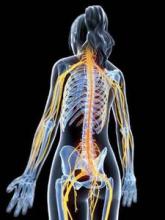The findings of a new multicenter, multinational cohort study of radiologically isolated syndrome offer further evidence that the condition should be part of the multiple sclerosis treatment spectrum because of the rate at which patients progressed to primary progressive MS over the course of the study.
“This is the first report of the temporal course within the preprogression phase for an extremely rare group of subjects originally identified by MRI as having asymptomatic disease, who ultimately experienced progressive symptom evolution consistent with PPMS [primary progressive MS] that could not otherwise be explained by any other mechanism (excessive alcohol use, vitamin deficiencies, etc.),” wrote the investigators, led by Dr. Orhun H. Kantarci of the Mayo Clinic in Rochester, Minn. (Ann Neurol. 2015 Nov 24. doi: 10.1002/ana.24564).
Dr. Kantarci and his coinvestigators evaluated 453 patients with radiologically isolated syndrome (RIS) across 22 centers in five different countries – the United States, France, Italy, Spain, and Turkey – and collected data on MRIs, lesions, and cerebrospinal fluids at baseline and during follow-ups for up to just over 20 years in certain cohorts. Demographic and clinical data were also analyzed for each patient enrolled.
Ultimately, 128 of the 453 RIS patients developed symptomatic MS (28%), of which 15 (12%) evolved to PPMS while the remaining 113 “developed a first acute clinical event related to [central nervous system] demyelination consistent with CIS [clinically isolated syndrome]/MS diagnosis.” RIS occurred at a median age of 43.3 years with a range of 20-66 years and evolved to PPMS at a mean age of 49.1 years. The median time to conversion was 3.5 years over a median follow-up period of 5.8 years (P = .05).
Nine PPMS subjects were male, and the remaining six were women; PPMS patients were more often men, compared with those who developed CIS/MS (P = .005). Additionally, median age at the onset of RIS and median age at symptomatic evolution were both older by about 10 years in subjects with PPMS versus those that developed CIS/MS (P less than .001).
“The 12% prevalence of PPMS in this large RIS cohort, as well as age at PPMS onset, are strikingly similar to that of large clinical studies in MS,” the authors noted. “Studying RIS, therefore, provides an opportunity to better understand the onset of clinical MS and to test early intervention.”
Dr. Kantarci and his associates also pointed out that, in their study, the older age of PPMS onset versus CIS/MS was “clearly” independent of individual follow-up times. Therefore, they also concluded that “age dependence of progressive MS development, in the absence of previous clinical relapses despite having clear subclinically active MS, suggests that biological aging mechanisms may be a significant contributor for development of progressive MS.”
The study was conducted without any specific funding source. Dr. Kantarci and his colleagues did not report any relevant financial disclosures.


